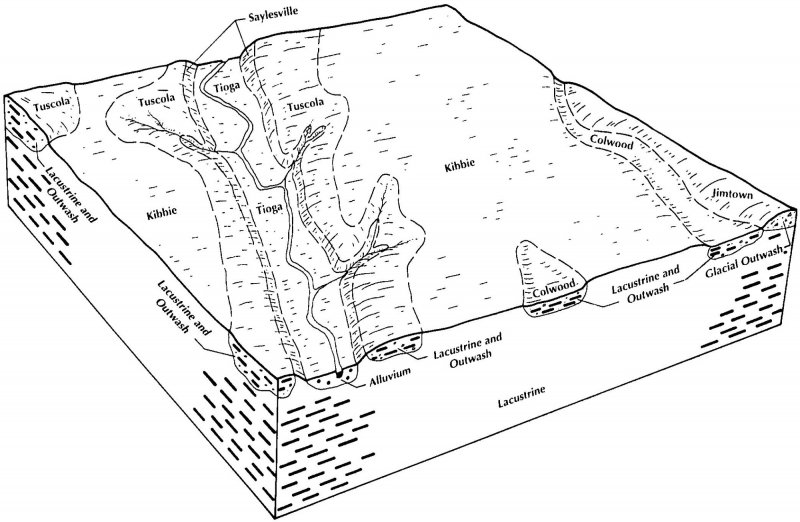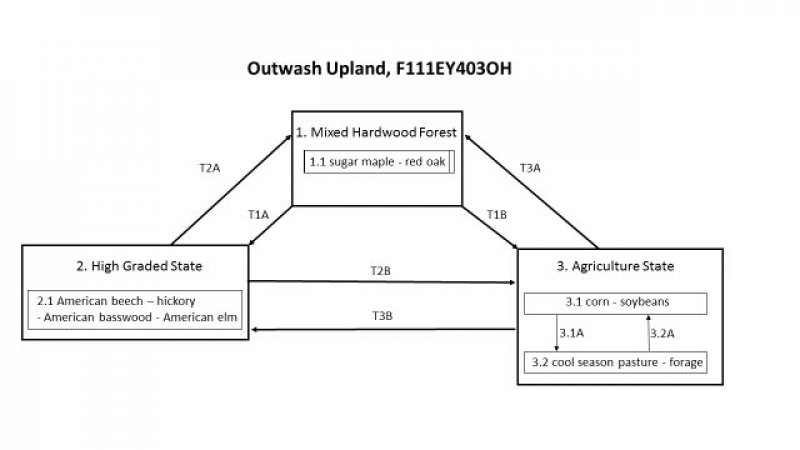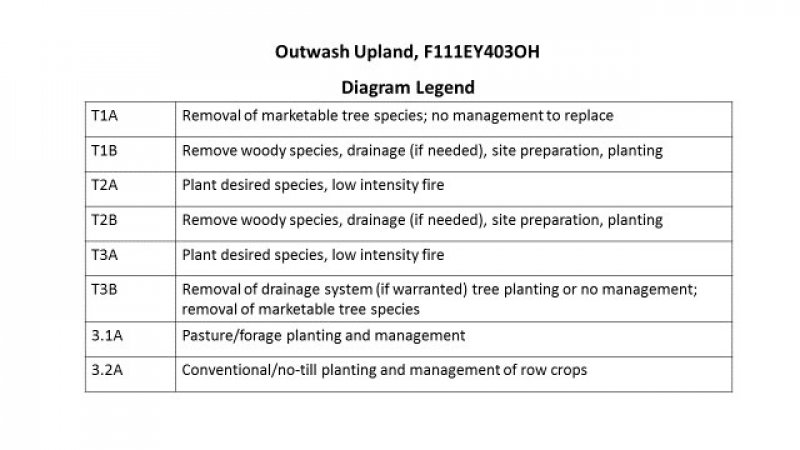
Natural Resources
Conservation Service
Ecological site F111XE403OH
Outwash Upland
Last updated: 9/11/2024
Accessed: 12/22/2025
General information
Provisional. A provisional ecological site description has undergone quality control and quality assurance review. It contains a working state and transition model and enough information to identify the ecological site.
MLRA notes
Major Land Resource Area (MLRA): 111X–Indiana and Ohio Till Plain
111E – Indiana and Ohio Till Plain, Eastern Part. Most of this area is in the Till Plains Section of the Central Lowlands Province of the Interior Plains. The northeast tip of the area is in the Southern New York Section of the Appalachian Highlands. The entire area has been glaciated. It is dominated by ground moraines that are broken in places by kames, lake plains, outwash plains, terraces, and stream valleys. Narrow, shallow valleys commonly are along the few large streams in the area. Elevation ranges from 580 to 1,400 feet (175 to 425 meters), increasing gradually from west to east. Relief is mainly a few meters, but in some areas hills rise as much as 100 feet (30 meters) above the adjoining plain.
The extent of the major Hydrologic Unit Areas (identified by four-digit numbers) that make up this MLRA is as follows: Scioto (0506), 33 percent; Muskingum (0504), 31 percent; and Western Lake Erie (0410), 28 percent; Upper Ohio (0503), 5 percent; and Southern Lake Erie (0411), 3 percent. The headwaters of many rivers in central Ohio, including the Vermillion, Black Fork, Sandusky, Little Scioto, and Olentangy Rivers, are in this MLRA.
This MLRA is underlain by late Devonian shale and sandstone. Surficial materials include glacial deposits of till, glaciolacustrine sediments, and outwash from Wisconsin and older glacial periods.
Classification relationships
Major Land Resource Area (USDA-Natural Resources Conservation Service, 2006)
USFS Ecological Regions (USDA, 2007):
Sections –Central Till Plains, Beech Maple (222H), Western Glaciated Allegheny Plateau (221F)
Subsections – Allegheny Plateau (221Fa), Bluffton Till Plains (222Ha), Miami-Scioto Plain – Tipton Till Plain (222Hb)
NatureServe Systems anticipated (NatureServe, 2011): Agriculture - Cultivated Crops and Irrigated Agriculture, Agriculture – Pasture/Hay, North-Central Interior Beech-Maple Forest, North-Central Interior Dry-Mesic Oak Forest and Woodland
LANDFIRE Biophysical Settings anticipated (USGS, 2010): North-Central Interior Beech-Maple Forest, North-Central Interior Dry-Mesic Oak Forest and Woodland
Ecological site concept
This woodland site was, historically, a mixed hardwood site with sugar maple and red oak being the dominant canopy species. Canopy associates include American beech, basswood, black cherry, and white oak. Fires were low frequency, high intensity events on the site at maturity and occurred very rarely, and even then only after large windthrow events or extreme drought. Low intensity, surface fires were more common in the mid seral stages when more fire tolerant species, oaks specifically, were more dominant in the canopy. Small gap disturbances are the most common overall disturbance mechanism and often result from windthrow or disease. Selective tree harvest moves the site to a new state where the canopy becomes dominated by less desirable timber species like beech, basswood, hickory and elm species. Currently, large areas of the site have been converted for agricultural use, mostly row crops and small grains, but some are being used for hay and pasture as well.
Associated sites
| R111XE401OH |
Wet Outwash Mollisol Soils are very poorly or poorly drained; soil surface is darker in color |
|---|---|
| R111XE402OH |
Dry Outwash Mollisol Soils are somewhat poorly drained or dried; soil surface is darker in color |
| F111XE404OH |
Dry Outwash Upland Soils are moderately well drained or drier |
Similar sites
| F111XE102OH |
Lacustrine Forest Located on lacustrine parent materials; soils are somewhat poorly drained or drier. |
|---|---|
| F111XE503OH |
Till Ridge Located on glacial till parent materials; site located on a convex landscape position; soils are moderately well to well drained. |
Table 1. Dominant plant species
| Tree |
(1) Acer saccharum |
|---|---|
| Shrub |
Not specified |
| Herbaceous |
Not specified |
Click on box and path labels to scroll to the respective text.



